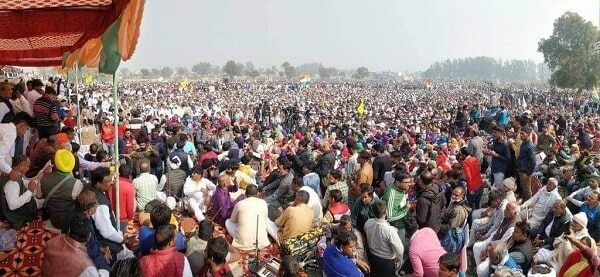Hundreds of thousands of farmers have been protesting in India since September last year in what has become the largest farmers protest in India’s history. Their protests against changes to agricultural laws by the Indian parliament – rammed through without debate in the middle of a pandemic – show no sign of abating. Instead, they now have support from civil rights bodies and labour unions in India, uniting across language and caste.
Internationally, they recaptured mainstream attention when Rihanna and Greta Thunberg tweeted about it three weeks ago. The Landless Worker’s Movements in Brazil, one of the largest movements in South America, have expressed solidarity with the farmers, as have a variety of labour, farming and civil groups in Canada, members of the UK Parliament, and 87 American farming and food justice groups who urged people to connect the dots between neoliberalism and farmers decline in India and the US.
Farmers’ protests aren’t new in India. These protests are preceded by decades of mismanagement, imperialism and corporate greed, and to understand them, we need to go back to the first attempt at ‘reforming’ Indian agriculture in the 1950s. Limited mostly to northern Indian states, the ‘Green Revolution’ (a term coined by the US state department) introduced industrial agricultural methods: fertilizers and pesticides, new varieties of wheat and rice and capital intensive practices. Studies at the time showed that smaller land holdings were more productive, but the Congress government didn’t want to upset its vote banks by redistributing land, so chose the easier option. Over time, damage from fertiliser and pesticide use led to ecological degradation and low yields, farmer debt increased and triggered a wave of farmer suicides.

The second wave of ‘reforms’ was even more destructive. The ‘structural adjustment’ loan that India took from the International Monetary Fund in 1991 came with three main conditions:
- liberalisation: reduction of government controls
- privatisation of the public sector
- globalisation: reduction of subsidies and import barriers to enable free trade.
This brought in large private multinationals like Monsanto and Cargill. The seed market opened up: prices in Andhra Pradesh went from Rs. 70 per acre in 1991 to Rs. 1000 in 2005 (an increase of 1429%), requiring a huge upfront investment by farmers. Pesticide subsidies were removed (an explicit condition of the IMF loan), electricity tariffs were increased and import duties protecting Indian farmers were removed. The price of cotton and pepper crashed heavily, impacting Maharashtra and Kerala. From 1997 to 2005, 149,244 farmers committed suicide, 17,131 in 2005 alone. Monsanto’s profit in 2005 was US$255 million.
READ ALSO: India farmers’ protests: internet shutdown highlights Modi’s record of stifling digital dissent
The latest set of legislative changes seek to further weaken government control by wresting control away from states and to the centre, where very few laws exist to regulate behaviour. They remove regulation intended to prevent hoarding, meaning prices can be driven up and allow farmers to enter into contracts with the private sector, pitting farmers against corporates like Reliance and Adani with no legal recourse for farmers to sue anybody under the act.
The government’s rationale is that these laws will make farmers’ lives better and create jobs. However, India’s own history, and the evidence from privatisation, structural adjustment and globalisation across the world tells a very different story. Structural adjustment similar to what India went through in 1991 cut the growth rate in developing countries from 3% to 1.7%. In sub-Saharan Africa, it nearly doubled the number of Africans living in poverty. After nearly 5 decades of industrialisation, structural adjustment and globalisation ‘reforms’ in Indian agriculture, the average per capita income per month in agricultural households in the last national survey was Rs. 1,300 (less than 1 AUD a day).

Inequality across the world is extreme, and getting worse. Unbridled privatisation only serves a select few: as Texas’s private grid collapsed in the recent freeze, electricity surged to US$ 9,000 an hour in some places. The pandemic has laid bare the flaws in our current model: billionaires’ wealth increased by US$ 3.9 trillion between March and December 2020, while the world’s poor will take more than a decade to recover from the pandemic.
And it is in the midst of this pandemic, one that impacts the most vulnerable the worst, that the Modi government is seeking to further weaken a largely impoverished population. The increasingly authoritarian tactics of the government have seen India drop from 142 to 180 in the Press Freedom Index, three spots behind Myanmar.
The jailing of Disha Ravi, suspension of activists’ Twitter accounts, characterisation of farmers as ‘parasites’, the wilful attempt to communalise the protests by claiming that farmers were ‘Khalistan separatists’ and suspension of the internet during the protests make it clear that the government’s actions aren’t just misguided ideology or an overzealous enthusiasm for dysfunctional models. It is a clear-eyed pursuit of profit and power. And the farmers’ protests are no longer merely for their survival and livelihood, but a fight for a fading democracy.
You can donate to support farmers at saveindianfarmers.org or khalsaaid.org
Dipanjali Rao is the author of a chapter in the book Globalization: Sectoral impacts and country experiences (ICFAI press 2009) on the impact of globalisation on Indian agriculture.
READ ALSO: Women take lead roles in India’s farmers’ protest
Link up with us!
Indian Link News website: Save our website as a bookmark
Indian Link E-Newsletter: Subscribe to our weekly e-newsletter
Indian Link Newspaper: Click here to read our e-paper
Indian Link app: Download our app from Apple’s App Store or Google Play and subscribe to the alerts
Facebook: facebook.com/IndianLinkAustralia/
Twitter: @indian_link
Instagram: @indianlink
LinkedIn: linkedin.com/IndianLinkMediaGroup




